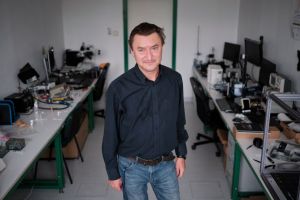Professor Arkadiusz Józefczak of the AMU Chair of Acoustics has co-authored a publication published in Ultrasonics Sonochemistry. The paper describes research on Pickering emulsion as a sound-active material. The results obtained by the researchers may improve the efficiency of ultrasound therapies used in cancer.
Ultrasonics Sonochemistry Journal is among the leading international journals publishing papers on ultrasound and sonochemistry research. The publication by Poznan acousticians comprising Prof. Arkadiusz Józefczak, Rafał Bielas, PhD, Bassam Jameel, MA, and Yaroslav Harkavyi, MA, is entitled “Optimization of ultrasound heating with Pickering droplets using core-shell scattering theory,” and concerns the potential use of Pickering emulsions in hyperthermia, or ultrasound heating, with possibility therapeutic effects. An emulsion is a colloidal system of two immiscible liquids, in which, one phase is dispersed in the other phase in the form of droplets. Pickering emulsion, in contrast, refers to such an emulsion stabilized by particulate matter accumulated on the surface of the droplets.
Thermal tissue heating, induced by the absorption of ultrasound at megahertz frequencies, is one of the earliest applications of ultrasound in medicine. It turns out that the effectiveness of ultrasound in hyperthermic therapy can be significantly improved by placing sound-active materials in the heated tissue. The latter can maximize the effects of hyperthermia, as they considerably increase the attenuation and scattering of the ultrasound wave. A variety of materials can be used for this purpose, including magnetic nanoparticles and Pickering droplets stabilized with such particles. It is precisely the latter that has been proposed in the described work. The numerical calculations presented therein, combined with computer simulations, allowed optimizing the efficiency of ultrasonic heating in materials imitating soft tissues filled with emulsions of different droplet sizes and the thickness of the coating around them. It was shown that these parameters affect the attenuation of ultrasonic waves, resulting not only in different temperature increases but also in the depth of penetration of ultrasonic waves.
